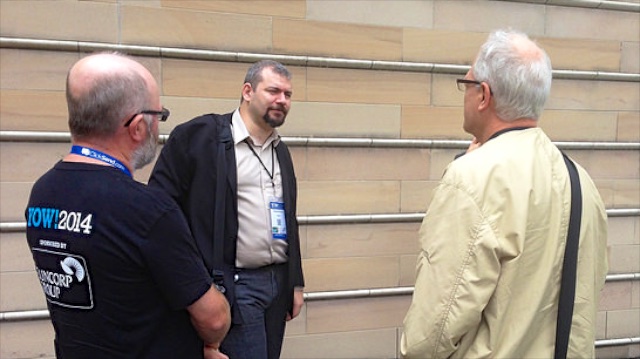The Merits of Explanation
05 Mar 2015
I had the privilege of listening to and meeting Ed Kmett at the YOW! conference in Sydney last December.

Ed is pictured in the centre, Scott Shaw on the right and yours truly on the left.[1]
Learning to Learn
Whilst Ed’s Functionally Oblivious and Succinct talk was undeniably impressive, it was his Stop Treading Water: Learning to Learn (download slides: 43MB) keynote which struck more of a chord with me.
I found the whole of Ed’s keynote fascinating. I love philosophical talks like this that provoke the listener into tangential thinking.
Ed drew upon a variety of references to shape what he had to say about how we can better learn. I liked his emphasis of the importance of revisiting something you have already learned, ideally when you’re just about to forget it, and improving your understanding by exploring the topic in more depth.
As a case in point, I’ve forgotten the details of what underpinned this point in Ed’s talk. Revisiting his slides, I now recall that he presented a hypothesis known as the forgetting curve which was developed by Hermann Ebbinghaus in 1885. Ebbinghaus showed that there is an exponential loss of memory unless information is reinforced. This leads to the idea of using the spaced repetition learning technique to achieve iterative deepening of knowledge.
Explaining Jargon
Another aspect of Ed’s talk that struck a chord with me was when he spoke about the need to be careful with jargon.
To quote from his keynote:
If you use jargon, always be willing to explain what it means.
Ed reminisced about answering questions in maths exams at school when the answer was obvious to him. This brought back memories of my own. Why bother going through all the intermediate steps to show how the answer could be derived when you could work it out in your head?
Getting back to Ed’s talk, he also alluded to how the work of French Mathematician Jean-Pierre Serre was taken to a higher level of abstraction by Alexander Grothendieck. Whereas Serre presented brilliant yet concise proofs, Grothendieck was renowned for his mastery of explanation.
What Ed had to say about the benefits of explanation set me thinking about how this applies to activities in software development, especially within a team.
Here are some examples.
Validating Design
An aspect of the Agile approach to developing software has been the reaction against Big Design Up Front. However, in my humble opinion, this has often been an over-reaction.
Sure, it can be crippling to the flow of developing software to spend a lot of time designing before writing code.
However, taking the time and putting in the effort to explain your intended design early can reap dividends. It may simply involve a small group of people discussing some rough design diagrams on a whiteboard. Or it may be an asynchronous discussion, perhaps including sketched diagrams, in a GitHub pull request[2]. Explaining a design idea to your colleagues can often save much time and effort if it reveals a better approach before significant time and effort has been invested in coding and testing.
Sharing Knowledge
Spreading knowledge throughout a software development team is, in my experience, more important than often fully appreciated.
In the day to day work towards delivering new features and getting the things done that the business needs done, one thing that can get left behind is the effective transfer of knowledge about the domain and how applications and technologies support the domain.
A potential antidote to this effect is for more deliberate effort to be put into explaining various aspects of what members of the software development team are doing.
Where it is recognised that one developer is the only team member with a thorough understanding of one critical system, sub-system or technology, a lunch-time talk could provide the opportunity for others to learn from the expert developer’s explanation. Alternatively, details of an approach to developing a feature could be elaborated on within a GitHub PR. Or perhaps explanation could be provided in an online question and answer discussion within whichever online communication tool the team is using.
The important thing is the preparedness of everyone in the team to share their knowledge for the good of the team as a whole.
Explanatory Debugging
A third example of the benefits of explanation in the context of programming, and one of my favourites, is what I refer to as explanatory debugging.
Have you ever found yourself stuck when trying to debug a software problem? I know I have on many an occasion.
At times like this when I have swallowed my pride and asked for a colleague to help, what happens next can be uncanny. Once I have their attention, I begin to show my colleague the code and explain the problem to them. It’s amazing how many times I don’t even get to finish explaining the issue before I see the source of the problem. To me, this scenario is one of the most powerful examples of how pair programming can work well. The simple act of explaining the problem so often quickly leads to a resolution.
In Conclusion
In a nutshell, being prepared to explain your reasoning is powerful. If you consider your reasoning to be important, taking the time and effort to share it will most likely lead to a better shared outcome.
And, on that note, I would like to thank Ed Kmett again for his thought-provoking keynote!
Footnotes
[1] Many thanks to YOW! for permission to reuse this photo.
[2] I intend to say more about effectively using Github PRs in another post soon.
Other posts
Previous post: Loving Legacy Code
More recently: Bundler and Disk Space